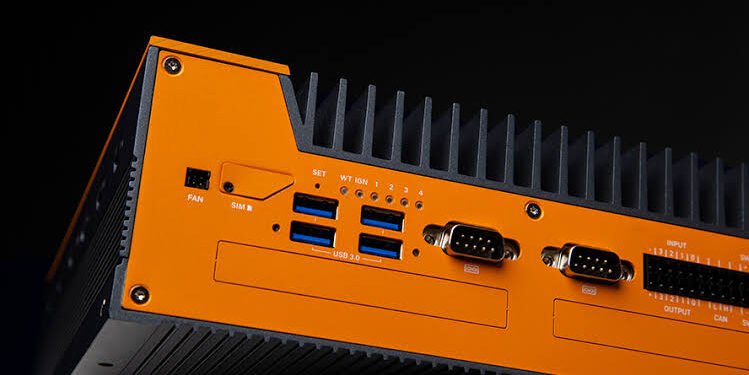Exciting news for tech enthusiasts! Say goodbye to bulky, noisy computers and welcome the smart future of technology with fanless embedded computers. These compact devices revolutionize interaction, offering benefits like energy efficiency and silent operation. Explore five compelling reasons why they’re the dream future for every tech enthusiast!
5 Reasons Why Fanless Embedded Computers Are the Future of Technology Today
Reason #1: Compact and Space-Saving Design
Their compact and lightweight design is propelling fanless embedded computers into various industries, seamlessly integrating into sectors like industrial automation and transportation. Technological advancements enable these devices to uphold high performance while saving valuable space.
Their sleek form factor guarantees functionality in different environments, and the modular design facilitates customization without occupying substantial physical space. This optimization not only boosts operational efficiency but also signals future advancements, potentially revolutionizing our daily use of technology with even smaller yet more powerful fanless embedded computers.
Reason #2: Enhanced Durability and Reliability
Fanless embedded computers, positioned as the future of technology, enhance durability and reliability. Unlike their traditional counterparts that rely on cooling fans, these devices thrive in harsh conditions, minimizing breakdown risks. With fewer components prone to failure, they boast higher reliability and reduced system failure risks.
The absence of fan noise and vibrations contributes to less wear and tear, extending their lifespans. Crafted with ruggedized enclosures, fanless embedded computers endure dust, moisture, shock, and temperature fluctuations—making them ideal for challenging industrial settings. Furthermore, eliminating the need for cooling fans results in minimal maintenance, saving time and reducing servicing costs.
In addition to manufacturing plants, transportation systems, outdoor installations, and healthcare facilities, fanless embedded computers are appealing because of their enhanced durability and reliability. In contrast to conventional computing solutions, they can withstand tough conditions and consistently deliver performance.
Reason #3: Improved Energy Efficiency
Fanless embedded computers, hailed as the future of technology, shine with superior energy efficiency compared to traditional systems. By ditching fans and embracing passive cooling methods like heat sinks, these innovations effectively dissipate heat without guzzling excessive power, leading to reduced electricity bills and a greener planet.
Their energy efficiency opens up a world of possibilities—powered by low-energy processors, running on battery packs, or even utilizing solar panels in remote areas with limited electricity access. Less heat generated means lower overall energy consumption.
What’s more, the improved energy efficiency allows these silent operators to thrive in noise-sensitive environments like hospitals and libraries. Beyond just cost-cutting, fanless embedded computers minimize environmental impact while ensuring reliable performance across diverse settings. In a nutshell, they’re not just gadgets; they’re the silent, energy-efficient revolution shaping the future of technology.
Reason #4: Reduced Noise and Heat Generation
Fanless embedded computers offer a superior solution for environments that require reduced noise and heat. Unlike traditional fan-based systems, these computers operate almost silently and are perfect for sensitive settings such as healthcare facilities or recording studios. In addition to creating a peaceful work environment, this innovative design eliminates distractions and discomfort caused by constant humming or whirring sounds.
By eliminating moving parts that are often subject to wear and tear, fanless embedded computers also improve device durability. They achieve effective cooling through passive techniques and heat sinks, avoiding the need for fans while maintaining peak performance.
This approach not only ensures reliability but also prevents overheating due to dust buildup, minimizing downtime associated with fan failures. Overall, fanless embedded computers offer a quiet and dependable solution without compromising on performance or longevity.
Reason #5: Flexibility and Adaptability
Fanless embedded computers are revolutionizing technology with their exceptional flexibility and adaptability. These compact devices seamlessly integrate into various applications, offering customization in industrial automation, transportation, healthcare, and more. With diverse connectivity options, they easily link up with peripherals and networks, accommodating expansion needs and integrating into existing systems.
What sets them apart is their remarkable scalability, supporting multiple input/output ports for hassle-free upgrades without compatibility concerns. Built to endure extreme conditions like high temperatures and vibrations, their rugged design ensures reliable operation where traditional cooling systems might falter.
Beyond their physical adaptability, these computers shine in software flexibility. Their open architecture design and compatibility with popular operating systems empower developers to customize software solutions for specific project requirements.
Advancements in Fanless Technology
Fanless embedded computers have evolved significantly, driven by continuous technological advancements. Manufacturers focus on enhancing performance and capabilities:
- Enhanced Graphics and Multimedia: Modern fanless computers now feature advanced GPUs, important for sectors like digital signage requiring high-definition visuals.
- Remote Management: Many fanless systems now provide remote management features, enabling troubleshooting and updates in remote or inaccessible locations without requiring physical intervention.
- Edge Computing: Designed to support edge computing, fanless embedded systems actively reduce latency and enhance real-time decision-making, especially in industrial IoT applications.
- Environmental Sustainability: Manufacturers actively prioritize sustainability by utilizing eco-friendly materials, ensuring energy efficiency, and adhering to industry standards for a reduced environmental impact.
- Integration with AI and ML: Fanless systems increasingly integrate AI and ML capabilities, actively enabling advanced analytics and on-site decision-making for more intelligent and responsive applications.
- Modularity and Customization: Some fanless computers actively adopt modular designs, allowing for easy customization and upgrades, and enhancing adaptability to evolving technological requirements.
- Improved Durability: Ongoing advancements in materials and manufacturing processes actively contribute to fanless embedded computers becoming more durable and resistant, especially important in rugged industries like transportation and manufacturing.
- Security Features: With the growing importance of cybersecurity, fanless embedded computers actively incorporate enhanced security features, including hardware-level measures and support for encryption protocols.
The evolution of fanless embedded computers involves an active and holistic approach, encompassing hardware, connectivity, software, sustainability, and security. These advancements collectively actively enhance adaptability and performance in diverse industrial settings.
Potential Challenges and Solutions
While fanless embedded computers offer significant advantages, potential challenges highlight their limitations:
- Thermal Design Considerations: Heat sinks and liquid cooling address overheating, but their effectiveness depends on the application and environment, requiring additional thermal management solutions in extreme conditions.
- Application-Specific Considerations: Suitability depends on application requirements; while ideal for certain environments, applications with high processing demands may benefit from actively cooled systems, necessitating careful consideration for the intended use case.
- Scalability: Fanless systems may have scalability limitations compared to actively cooled ones. Organizations planning expansions or with evolving computing needs must consider potential scalability challenges associated with fanless solutions.
- Educational and User Awareness: User education on maintenance practices, environmental factors, and ventilation requirements is important for system longevity and optimal performance.
- Market Acceptance and Standardization: Broader market acceptance and standardization can address cost concerns, potentially reducing overall costs through economies of scale as fanless technology advances.
- Integration Challenges: Integrating fanless systems into existing infrastructures, especially in established industries, may pose challenges. Compatibility with legacy systems and seamless integration into workflows need careful consideration during adoption.
Overcoming these challenges requires a holistic approach involving technological innovations, user education, and industry-wide standardization efforts. As technology progresses, collective efforts from manufacturers and users will establish fanless embedded computers as reliable and efficient computing solutions.
Conclusion
In conclusion, fanless embedded computers are at the forefront of reshaping the future of computing. Their compact design, enhanced durability, improved energy efficiency, and adaptability mark a significant shift in computing paradigms, especially evident in industries like healthcare and transportation.
The continuous advancements in fanless technology, emphasizing thermal management and high performance, showcase ongoing efforts to overcome challenges such as potential overheating. The devices’ flexibility allows seamless integration into various applications without compromising reliability, and their enhanced durability ensures sustained operation in challenging conditions.
The benefits of improved energy efficiency, reduced power consumption and minimized environmental impact, coupled with lower noise and heat generation, contribute to creating a more comfortable working environment. With ongoing advancements, fanless embedded computers are positioned to lead technological progress, providing customizable solutions that do not compromise functionality or performance.
















